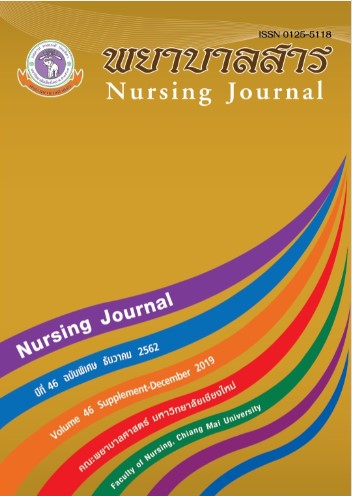The effect of social support program combined with physical exercise on quality of life in Major Depressive Disorder patients
Keywords:
Social support, Exercise, quality of life, Major Depressive Disorder patientsAbstract
This study is a quasi-experimental pretest-posttest control groups research design. The objects were to compare :1) quality of life in Major Depressive Disorder patients (MDD) before and after received social support program combined with physical exercise, and 2) quality of life in Major Depressive Disorder patients who received social support program combined with physical exercise and those who received regular nursing care. The samples of 40 MDD patients that met the inclusion criteria were recruited patients who living in community, Muang district, Phetchaburi province. The samples were matched-pairs with age and duration of illness then randomly assigned into either experimental or control group, 20 subjects in each group. The experimental group received social support program combined with physical exercise, whereas the control group received the regular nursing care. The research instruments consisted of: 1) social support program combined with physical exercise developed by the researcher based on concept of exercise by Schuch et al.(2015) and concept of social support by House(1981) 2) The tools used for collecting data are the quality of life indicators of the World Health Organization, Thai version by Mahatniranakul,S.,et al.(1997) All instruments were tested for content validity by 5 experts. The reliability of the instruments were analyzed by finding Cronbach's alpha coefficient as of .89 and .90 respectively. Analyze general data using average values Standard deviation and t-test.
The conclusion of this research were as follows:
- The average score of quality life in Major Depressive Disorder patients after received social support programs combined with physical exercise were higher than before received with statistical significance at the level of .05
- The average score of quality of life in Major Depressive Disorder patients who received social support programs combined with physical exercise were higher than those who received regular care with statistical significance at the level of .05
References
Chinwararak,C.& Luebunthawatchai,P. (2016). Physical symptoms and the relationship with the severity of depressive symptoms in depressed patients in Chulalongkorn Hospital.
Journal of the Medical Association of Thailand.61(4): 281-294. (In Thai)
Du, X. (2014). BDNF–TrkB signaling as a therapeutic target in neuropsychiatric disorders. Journal of Receptor, Ligand and Channel Research 7, 61-79.
Department of Mental Health.(2010).Depression management guidelines for general practitioners in primaryand secondary levels.Ubon Ratchathani: Siritham Offset.(In Thai)
Gerber, M., Holsboer-Trachsler, E., Pühse, U., & Brand, S. (2016). exercise is medicine for patients with major depressive disorders: but only if the “pill” is taken!. Neuropsychiatric Disease and Treatment 12,1977.
House, J. S. (1981).Work stress and social support. Massachusetts: Addison-WesleyPublishing.
Intharit,J. (2013).in Sattayatham,C.& Chan Suk,P.& Charoensuk,S.(Editor). Depression and nursing. Psychiatric Nursing and Mental Health.(Revised Edition) 2nd.Bangkok: Thana Place. (In Thai)
IsHak, W. W., Greenberg, J. M., Balayan, K., Kapitanski, N., Jeffrey, J., Fathy, H., ... & Rapaport, M. H. (2011). Quality of life: the ultimate outcome measure of interventions in major depressive disorder. Harvard review of psychiatry 19(5), 229-239.
Kongsuk,T., Pimtra,S. & Liachongpeampoon,J. (2012). Quality of life and predictive factors in Thai
depression patients. Ubon Ratchathani: Phra Sri Maha Pho Hospital. (In Thai)
Luanglak,R. (2009).Strengthening motivation in promoting exercise in patients with depression. Kumphawapi Hospital. Master’s thesis, Nursing Science Program in Mental Health and Psychiatric Nursing, Faculty of Nursing, Khonkean University. (In Thai)
Malchow, B., Reich-Erkelenz, D., Oertel-Knöchel, V., Keller, K., Hasan, A., Schmitt, A., ... & Falkai, P. (2013). The effects of physical exercise in schizophrenia and affective disorders. European archives of psychiatry and clinical neuroscience 263(6), 451-467.
Mahatniranakul,S. et al.(1997) . Compare the World Health Organization's quality of life measure every 100 indicators and 26 indicators, Suan Pung hospital Chiangmai Province. (In Thai)
Pleankerd,P. (2014). Depression: Nursing roles in care. Royal Thai Army Nursing Journal 15(1):18-21. (In Thai)
Rakkarn,J.(2006).The effect of using family mental health program on the care burden of schizophrenic caregivers in community.Master’s thesis, Nursing Science Program in Mental Health and Psychiatric Nursing,Faculty of Nursing,Chulalongkorn University.(In Thai)
Schuch,F.B., Vasconcelos-Moreno, M.P., Borowsky,Zimmermann, Rocha, N.S., & Fleck, M. P. (2015). Exercise and severe major depression: effect on symptom severity and quality of life at discharge in an inpatient cohort. Journal of psychiatric research 61, 25-32.
Stanton, R., Happell, B., Hayman, M., & Reaburn, P. (2014). Exercise interventions for the treatment of affective disorders–research to practice.Frontiers in Psychiatry 5, 1-4.
WHO. (2016). Depression.Retrieved 13 April 2016, from http://www.who.int/mediacentre
Downloads
Published
How to Cite
Issue
Section
License
บทความที่ได้รับการตีพิมพ์เป็นลิขสิทธิ์ของวารสารพยาบาลสาร
ข้อความที่ปรากฏในบทความแต่ละเรื่องในวารสารวิชาการเล่มนี้เป็นความคิดเห็นส่วนตัวของผู้เขียนแต่ละท่านไม่เกี่ยวข้องกับมหาวิทยาลัยเชียงใหม่ และคณาจารย์ท่านอื่นๆในมหาวิทยาลัยฯ แต่อย่างใด ความรับผิดชอบองค์ประกอบทั้งหมดของบทความแต่ละเรื่องเป็นของผู้เขียนแต่ละท่าน หากมีความผิดพลาดใด ๆ ผู้เขียนแต่ละท่านจะรับผิดชอบบทความของตนเองแต่ผู้เดียว






